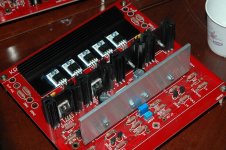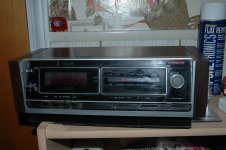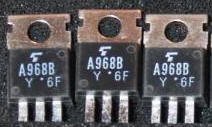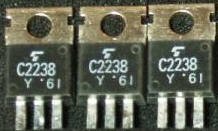Amazing, in it self, the X-CAP lasted 30 years. Will you have to recalibrate the oscilloscope?Sorry for kicking the topic, but I could not edit the post above.
Well guys, I blamed the clips, because when changing them the problems were over. But, believe it or not, but 4 minutes after I sended the post above, my oscilloscope went blank and loads of smoke came out of it. It was pretty impressive. Pfew, that stinks. Took the oscilloscope outside. It kept smoking for a wile.
I had an earlier discussion with David (Spurtle) about the so called 'rattle capacitor'. These oscilloscopes have one too. They are from Rifa. Altough quality is not that bad, after 30 years they go short circuit (X2 capacitor my a**). Here is a picture of it, I would not even imagine what would have been happened if I don't was in my room:
An externally hosted image should be here but it was not working when we last tested it.
(blue one is the replacement)
An externally hosted image should be here but it was not working when we last tested it.
Unbelievable how much smoke can come out of such a little capacitor. Replaced it, cleaned the print and decided to clean the potentiometers and switches with some Tuner 600 spray. This is very good spray btw, leaves absolutely no residue. Prayed that it would work again, because Kaplaars is a bit broke nowadaysAnd IT DID!!!
The oscilloscope had some stability problems earlier with triggering and al sorts of strange distortions. Thought that was due to the clips, but it turned out it was actually caused by the oscilloscope itselve! So another note to myself, when testing equipment NEVER leave the room.
Amazing, in it self, the X-CAP lasted 30 years. Will you have to recalibrate the oscilloscope?
Hi David,
To be honest, I don't know how I have to calibrate it. I am afraid I don't have adequate equipment to do that. I think that is not nessesairy because the X-cap does not have a direct influence on measurements. Only indirect for example when it is broken it can cause the scope to give 'strange' measurements, because it leaks current. I also noticed the last few days that when I switched a light on or something like that, it influenced the measured values a bit. With the new cap, it is like it was before; perfect
It seems measurements are now as it has to be, nice 10kHz square sine wave at 40 VAC RMS, no oscillaton to see. Very happy with that, Jim did an excellent job with creating this boards
Little update, now my scope is entirely fixed up and measurements are realy good (even 20 kHz ssquare wave at max power no distortion at all!!!), it is time to deal with temperature.
I felt realy stupid yesterday, turns out my DVM has an option to measure temperature with a probe (max 3 degrees deviation)! So removed one of the fans and insterted the probe into the outtake of cooling tunnel. Turns out temperature is about 68 degrees inside @ 444 mV bias, ambient temperature of 32 degrees (for Dutch standards it gets very hot in my room when the sun is shining) and 1,5 hour power on:
It turns out my spreadsheet (http://michaelq.home.xs4all.nl/Projects/Bias vs. power derating.xlsx) does a very good prediction! Calculated that C/W-value is slightly lower, it is about 0,21 C/W.
But this way I could not measure accurately how hot the TO-3 devices became. Also compairing the intake and outtake temperatures was a bit more difficult. I got an offer I could not refuse, some one offered me an IR-thermometer for 10 euro's! So I bought it .
.
At 444 mV bias, one fan at 50% I measurethis temperature at the intake (device has 2 degrees deviation):
And this temperature at the outtake:
AVwerk and Klaas were absolutely right, difference between in and outtake in the current setup is 18 degrees. 75 degrees should not harm the TO-3's when I calculate values. It is well within it's SOA. What dou you think guys? Will this shorten lifespan of the TO-3 drasticly? It has to work for at least 50 years No kiddin, but I want that it will be an relieable amplifier.
No kiddin, but I want that it will be an relieable amplifier.
As far as I am considered I can an do two things; separate the cooling tunnels. Going full bias would not be an problem then, or stick to this design and go for lower bias.
I shall do further measurements @ .625 mV bias. Temperatures should get a bit lower when adding fan two and when temperatures drop a bit in here.
I felt realy stupid yesterday, turns out my DVM has an option to measure temperature with a probe (max 3 degrees deviation)! So removed one of the fans and insterted the probe into the outtake of cooling tunnel. Turns out temperature is about 68 degrees inside @ 444 mV bias, ambient temperature of 32 degrees (for Dutch standards it gets very hot in my room when the sun is shining) and 1,5 hour power on:
An externally hosted image should be here but it was not working when we last tested it.
It turns out my spreadsheet (http://michaelq.home.xs4all.nl/Projects/Bias vs. power derating.xlsx) does a very good prediction! Calculated that C/W-value is slightly lower, it is about 0,21 C/W.
But this way I could not measure accurately how hot the TO-3 devices became. Also compairing the intake and outtake temperatures was a bit more difficult. I got an offer I could not refuse, some one offered me an IR-thermometer for 10 euro's! So I bought it
At 444 mV bias, one fan at 50% I measurethis temperature at the intake (device has 2 degrees deviation):
An externally hosted image should be here but it was not working when we last tested it.
And this temperature at the outtake:
An externally hosted image should be here but it was not working when we last tested it.
AVwerk and Klaas were absolutely right, difference between in and outtake in the current setup is 18 degrees. 75 degrees should not harm the TO-3's when I calculate values. It is well within it's SOA. What dou you think guys? Will this shorten lifespan of the TO-3 drasticly? It has to work for at least 50 years
As far as I am considered I can an do two things; separate the cooling tunnels. Going full bias would not be an problem then, or stick to this design and go for lower bias.
I shall do further measurements @ .625 mV bias. Temperatures should get a bit lower when adding fan two and when temperatures drop a bit in here.
Hi lgreen,
I was thinking about that, but... I can't mount a bigger fan to the cooling tunnel. I could buy some fan convertors, but than the heatsink can't fit in the cabinet. When I mount a bigger fan some of the airflow will not go through the tunnel, but go via the sides instead, so I think air pressure will be lower. But I haven't did that experiment, will do, maybe it will be better. And..... bigger fans are quieter
I've biassed it right now to 500 mV. Ambient temperature (measured at the TO-3 sockets with my new toy) is 35.5 degrees Celsius. With fans at full speed and mounted the two of them I get 70.2 degrees Celsius (=158.36 F) at the outtake and 53.8 C (=128.84 F) at the intake. The second fan did improve temperature a bit more. With one fan running at 50% I got @ 440mV bias 71.2 degrees Celsius at the outtake, with both fans running at 50% speed I got 68.4 C at the outtake.
I was thinking about that, but... I can't mount a bigger fan to the cooling tunnel. I could buy some fan convertors, but than the heatsink can't fit in the cabinet. When I mount a bigger fan some of the airflow will not go through the tunnel, but go via the sides instead, so I think air pressure will be lower. But I haven't did that experiment, will do, maybe it will be better. And..... bigger fans are quieter
I've biassed it right now to 500 mV. Ambient temperature (measured at the TO-3 sockets with my new toy) is 35.5 degrees Celsius. With fans at full speed and mounted the two of them I get 70.2 degrees Celsius (=158.36 F) at the outtake and 53.8 C (=128.84 F) at the intake. The second fan did improve temperature a bit more. With one fan running at 50% I got @ 440mV bias 71.2 degrees Celsius at the outtake, with both fans running at 50% speed I got 68.4 C at the outtake.
not sure if that is air temp or metal temp? anyway i bet you can monkey with it sufficiently to have 2 fans relatively silent with nice flow. if you are well below or at 100c at junction than dont sweat it. (hah!..."sweat") TO3 are good w heat so nice design choice. will heat your room a degree or 2 per hour. nothing is perfect so you may have to accept potential output stage failure at 15 years out vs. 25 years with optimal cooling.
from phone
from phone
Has anyone on here tried adjusting bias on his KSA-50 or 100 using a distortion analyzer at 10 khz while looking at the distortion content outpput on a scope? This is the way many an amp used to be biased (within limits of course). Just curious... I have the equipment...but not the time to do it.
Mark
Mark
Hi lgreen,
That is metal temp, straight on the top of the TO-3's. The heatsink itself gets ~3 degrees less warm, the air coming out of the tunnel cooler is about 42 degrees C. Will certainly try it. I have some big fans in my computer, but I need the computer and the computer needs the fans, so have to buy ones instead
Heeeeeyyyyyy that is good news, tested it yesterday at .625 mV. Got about 80 degrees C on top of the TO-3's at outtake. Intake was about 63 degrees. That would mean that even full biassed there is not a real problem. Nice to hear. Dean was right again, temperature is actually lower than I thought. I've red in 'designing audio power amplifiers' that you could put your finger on a 60 degrees heatsink for 30 seconds without feeling pain. Well I have a high pain tolerance, but at 60 degrees my fingers did realy hurt even for 2 seconds. The quote from mister Pass which Dean quoted is far more correct.
@ Mark, I haven't got a distortion analyser A good one is a bit too expensive for my budget. I was wondering if I could make cross over distortion visible with a scope and a signal generator. How would that look like? Tried it, but I did not see real changes when looking at the sinewave at the scope while lowering bias.
A good one is a bit too expensive for my budget. I was wondering if I could make cross over distortion visible with a scope and a signal generator. How would that look like? Tried it, but I did not see real changes when looking at the sinewave at the scope while lowering bias.
That is metal temp, straight on the top of the TO-3's. The heatsink itself gets ~3 degrees less warm, the air coming out of the tunnel cooler is about 42 degrees C. Will certainly try it. I have some big fans in my computer, but I need the computer and the computer needs the fans, so have to buy ones instead
Heeeeeyyyyyy that is good news, tested it yesterday at .625 mV. Got about 80 degrees C on top of the TO-3's at outtake. Intake was about 63 degrees. That would mean that even full biassed there is not a real problem. Nice to hear. Dean was right again, temperature is actually lower than I thought. I've red in 'designing audio power amplifiers' that you could put your finger on a 60 degrees heatsink for 30 seconds without feeling pain. Well I have a high pain tolerance, but at 60 degrees my fingers did realy hurt even for 2 seconds. The quote from mister Pass which Dean quoted is far more correct.
@ Mark, I haven't got a distortion analyser
Nice radio David! 
I am afraid I have some bad news, but when I see the 2SA968's on your board I think they are not original Toshiba. Especially the right one seems to be fake because the Toshiba logo is printed on it. Original ones look different. Original ones with the T Toshiba logo should look like these: http://michaelq.home.xs4all.nl/Projects/2sa2sc%20(2).JPG
I am afraid I have some bad news, but when I see the 2SA968's on your board I think they are not original Toshiba. Especially the right one seems to be fake because the Toshiba logo is printed on it. Original ones look different. Original ones with the T Toshiba logo should look like these: http://michaelq.home.xs4all.nl/Projects/2sa2sc%20(2).JPG
Yes David, I'm afraid Michael has right. The left one could be original KEC, but the right one is probably a fake. It will be a shame to spoil such a beautiful amp with a nasty components. It could work, but how...that is the question.
Btw Michael, genuine 2sa968/2sc2238 came with two Toshiba logos, old T and...
Btw Michael, genuine 2sa968/2sc2238 came with two Toshiba logos, old T and...
Attachments
Hmm, I hope David did not buy the MJ15003/4's from Ebay also. Buying trannies from Ebay is very risky. Best is to buy from official partners. Like Digikey which is a official partner from ONsemi.
Ahaa, I did not know that the 2SC968 / 2SC2238 came with the new logo too. I only knew the green and black version with the T-logo.
I've decoupled the KSA by the way. It is now time to wire GND in the cabinet. Will receive some nylon sleeves soon (company shipped wrong nylon sleeves, so had to wait for that). I promised to publish some pictures of the orientation of the boards. Now everything is disconnected I could make a photo easier. Here it is:
I am proud of the results I've used some spacers to connect the cables to. Very strong and relieable connection that almost can't corrode.
I've used some spacers to connect the cables to. Very strong and relieable connection that almost can't corrode.
And I have some other news, I finally have a Fluke multimeter!!! Although my other multimeter (Velleman DVM890) is very good and reliable (bought it back in 2006, never experienced any problems with it) I wanted to have a Fluke. But they are so expensive....... till today. Bought one for a very reasonable price second handed. It is a Fluke 175.
Little picture:
It is in great condition. The original little plactic protection shield was even mounted to the display. It is unbelievable what kind of quality this meter has. What I really like about it is the ability to check capacitors. It has also all kinds of safety things build in, like when you measure resistance and there is lot of voltage across the resistor it it bleeps, when you want to measure at a capacitor which is still charged it bleeps and so on. So you always know you are doing something wrong (did not try these things btw, but the manual says it ).
).
Well I am going to watch the opening of the Olympic Games further , good night all
Ahaa, I did not know that the 2SC968 / 2SC2238 came with the new logo too. I only knew the green and black version with the T-logo.
I've decoupled the KSA by the way. It is now time to wire GND in the cabinet. Will receive some nylon sleeves soon (company shipped wrong nylon sleeves, so had to wait for that). I promised to publish some pictures of the orientation of the boards. Now everything is disconnected I could make a photo easier. Here it is:
An externally hosted image should be here but it was not working when we last tested it.
I am proud of the results
And I have some other news, I finally have a Fluke multimeter!!! Although my other multimeter (Velleman DVM890) is very good and reliable (bought it back in 2006, never experienced any problems with it) I wanted to have a Fluke. But they are so expensive....... till today. Bought one for a very reasonable price second handed. It is a Fluke 175.
Little picture:
An externally hosted image should be here but it was not working when we last tested it.
It is in great condition. The original little plactic protection shield was even mounted to the display. It is unbelievable what kind of quality this meter has. What I really like about it is the ability to check capacitors. It has also all kinds of safety things build in, like when you measure resistance and there is lot of voltage across the resistor it it bleeps, when you want to measure at a capacitor which is still charged it bleeps and so on. So you always know you are doing something wrong (did not try these things btw, but the manual says it
Well I am going to watch the opening of the Olympic Games further , good night all
Last edited:
I just remembered that I got these from Mouser Electronics, USA. So they should be legit. It was the 2SK2013/2SJ313 I purchased through ebay from Israel. Here is their store site on ebay:Yes David, I'm afraid Michael has right. The left one could be original KEC, but the right one is probably a fake. It will be a shame to spoil such a beautiful amp with a nasty components. It could work, but how...that is the question.
Btw Michael, genuine 2sa968/2sc2238 came with two Toshiba logos, old T and...
4x 2SJ313 + 2SK2013 Original Toshiba MOSFET (2 + 2) | eBay
David, don't mess up with transistors of suspicious origin if you can't get the real mccoy. Get 2sa1011/2sc2344 like I told you. Mouser is no guarantee that these are the original transistors. A few years ago I ordered via RS Components Toshiba's 2sa968/2sc2238 and got Magnatec. They work fine but these were actually 2sa1011/2sc2344 transistors with polished front and re-printed logo and product labels. I've made a comparison. I even went well, but their price was pretty high and I could get a two original transistors for price of one. Just be careful.
Last edited:
What a 2012 Olympian opening show! I have here a post from AudioKarma
Toshiba 2SC2238 + 2SA968 counterfeits? [Archive] - AudioKarma.org Home Audio Stereo Discussion Forums
It talks about 2SA1837/2SC4793 as substitutes. I see that the only difference is that the Ic=1A. The 2sa968's Ic=1.5. Is this a big difference for the KSA 100?
Toshiba 2SC2238 + 2SA968 counterfeits? [Archive] - AudioKarma.org Home Audio Stereo Discussion Forums
It talks about 2SA1837/2SC4793 as substitutes. I see that the only difference is that the Ic=1A. The 2sa968's Ic=1.5. Is this a big difference for the KSA 100?
I could not agree with Dean more  I have very bad experiences with cloned / fake transistors. Repaired a Denon PMA-920 once. Replaced the original Sanken outputs for ISC's. 5 seconds full power at the dummy and BOOM. Sliced the trannies open, and.... well see for yourself, compaire the dies (left ISC, right good ol' Sanken):
I have very bad experiences with cloned / fake transistors. Repaired a Denon PMA-920 once. Replaced the original Sanken outputs for ISC's. 5 seconds full power at the dummy and BOOM. Sliced the trannies open, and.... well see for yourself, compaire the dies (left ISC, right good ol' Sanken):
That little joke made the repair even more costly, could replace the drivers again, and now the biastransistor and emitterresistors were broken also.
An externally hosted image should be here but it was not working when we last tested it.
That little joke made the repair even more costly, could replace the drivers again, and now the biastransistor and emitterresistors were broken also.
2SA1837/2SC4793 are not direct substitution, 2sa1011/2sc2344 are.
Semiconductor Substitution List
Edit: Michael, congratulation! Excellent Fluke
Semiconductor Substitution List
Edit: Michael, congratulation! Excellent Fluke
Last edited:
Thanks.David, don't mess up with transistors of suspicious origin if you can't get the real mccoy. Get 2sa1011/2sc2344 like I told you. Mouser is no guarantee that these are the original transistors. A few years ago I ordered via RS Components Toshiba's 2sa968/2sc2238 and got Magnatec. They work fine but these were actually 2sa1011/2sc2344 transistors with polished front and re-printed logo and product labels. I've made a comparison. I even went well, but their price was pretty high and I could get a two original transistors for price of one. Just be careful.
neychi, I talked to the owner of this electronic components store in New Jersey, USA
2SA1011 pdf 2SA1011 datasheet PNP Epitaxial Planar Silicon Transistor - High-voltag Switching - AF Power Amp - 100W Output Predriver Application 2.51735 Transistors Bipolar Silicon PNP Power Transistors American Microsemiconductor 2SA1011 available a as I found the 2SA1011 but not the the 2SC2344. I called and got the top man himself. He took all my information regarding the 2SA968/2SC2238 and the 2sa1011/2sc2344 and said he will get back to me shortly, at least by Monday. You guys are my guardian angels and I owe you a cold beer. And I also see the specs for the 2sa1011 where the Ic-1.5A. Nice
2SA1011 pdf 2SA1011 datasheet PNP Epitaxial Planar Silicon Transistor - High-voltag Switching - AF Power Amp - 100W Output Predriver Application 2.51735 Transistors Bipolar Silicon PNP Power Transistors American Microsemiconductor 2SA1011 available a as I found the 2SA1011 but not the the 2SC2344. I called and got the top man himself. He took all my information regarding the 2SA968/2SC2238 and the 2sa1011/2sc2344 and said he will get back to me shortly, at least by Monday. You guys are my guardian angels and I owe you a cold beer. And I also see the specs for the 2sa1011 where the Ic-1.5A. Nice
- Status
- This old topic is closed. If you want to reopen this topic, contact a moderator using the "Report Post" button.
- Home
- Amplifiers
- Solid State
- Stolen Trademark Amplifier from Jim's Audio on EBAY



